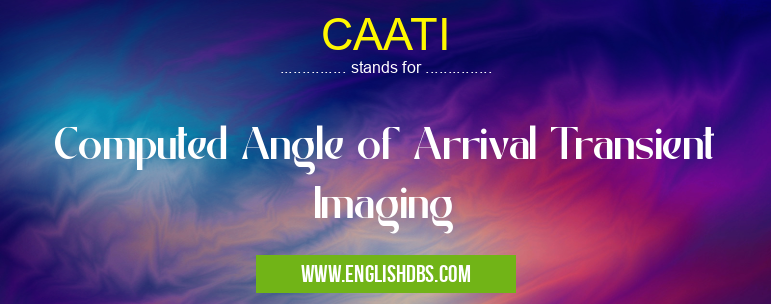What does CAATI mean in PHOTOGRAPHY & IMAGING
Computed Angle of Arrival Transient Imaging (CAATI) is a technology used to detect and analyze radio waves that are propagated through the atmosphere. It combines angle-of-arrival (AOA) sensing along with signal processing techniques such as pulse compression, beamforming, direction finding, and parameter estimation. CAATI offers the capability of detecting, characterizing, and tracking narrowband or wideband signals from various sources in a given area. This makes it an invaluable tool for surveillance and diagnosis applications within the military and civilian sectors alike

CAATI meaning in Photography & Imaging in Miscellaneous
CAATI mostly used in an acronym Photography & Imaging in Category Miscellaneous that means Computed Angle of Arrival Transient Imaging
Shorthand: CAATI,
Full Form: Computed Angle of Arrival Transient Imaging
For more information of "Computed Angle of Arrival Transient Imaging", see the section below.
Essential Questions and Answers on Computed Angle of Arrival Transient Imaging in "MISCELLANEOUS»PHOTOGRAPHY"
What is Computed Angle of Arrival Transient Imaging (CAATI)?
CAATI is an imaging technique which uses a combination of real-time video imaging and acoustic emission data to generate images of transient phenomena. This technique makes use of acoustic sensors and a real-time video camera to capture the signal emitted by the target being imaged. The captured signals are then processed in order to locate the target, estimate its speed, and convert this information into an image.
What type of phenomena can be captured using CAATI?
CAATI can be used to capture transient impacts or interactions in all kinds of materials such as metals, composites, plastics, etc. It can also be used to image moving objects, detect fault lines or cracks in structures, track shockwaves through materials and monitor changes in acoustic propagation over time.
How does CAATI help in studying transient phenomena?
CAATI allows for the visualization of transient phenomena within a material or structure by providing an image that can be interpreted by researchers and engineers. By capturing the signal emitted during an impact event it is possible to analyze the nature of the interaction taking place at very high speeds, while also gaining insight about how different materials interact with each other under dynamic loading conditions.
What type of equipment is needed for CAATI?
In order for CAATI to function properly it requires several pieces of equipment including a real-time video camera capable of capturing high resolution images at high speeds, several acoustic sensors arranged along the area where imaging is set to take place and specialized software that will process the data from both sources.
What kind of benefits does CAATI offer over traditional imaging techniques?
Compared to traditional imaging methods such as X-ray or ultrasound imaging which relies on static images that cannot capture transient events, CAATI offers vast improvement when it comes to accurately assessing how certain materials behave under highly dynamic conditions. Its ability to capture information quickly also makes it useful for monitoring events like explosions or ballistic impacts that occur over very short periods of time.
What applications does CAATI have?
Though its initial purpose was mostly geared towards military applications such as monitoring weapons performance or evaluating missile reentry dynamics there are numerous civilian applications as well such as tracking fracture propagation in aircraft components or examining industrial processes in order to improve safety standards. It has also become popular in sporting activities due golf ball launches and batting swings analysis among others.
What are some advantages associated with using CAATI?
Some major advantages related with using CAATI include minimal instrumentation requirements since no processing hardware is necessary for it function; its low cost since system scalability depends mainly on budget constraints; its higher accuracy compared with other systems; its high temporal resolution which allows for capturing events occurring within milliseconds; and its non-destructive nature that allows material properties assessment without causing any damage.
Is there any limitation associated with using this technology?
Yes there are certain limitations associated with using this technique mainly related with handling larger datasets . As data acquisition rates increases so does storage requirements meaning that large datasets might need additional computing capacity not available in some locations.
